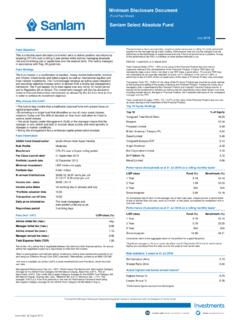Transcription of 2016 EY Latin America insurance outlook - Ernst & …
1 2016 EY Latin America insurance outlook2016 EY Latin America insurance outlook2 market summaryA market in flux Despite sluggish economic growth and troubling inflation in key markets, the 2016 insurance market outlook for Latin America remains relatively bright. The rollout of new insurance products and distribution approaches at a time of low market penetration should drive strong growth for insurers. insurance premium growth is expected to rise by around 6% 7% in 2016 and possibly beyond should the economic environment improve as expected. At the same time, the emergence of end-to-end digital capabilities is transforming the Latin American insurance market . This digital market disruption will force insurers to make rapid revisions to existing business models to stay competitive and build market share. Customer expectations rising Commercial customers will continue to require more sophisticated insurance solutions in 2016, including coverage for business interruption, cybersecurity, civil unrest, and errors and omissions.
2 Latin American consumers, many of whom are young, cosmopolitan and tech-savvy, will continue to push for new insurance channels and services that fit with their lifestyle. To respond, insurers will need to simplify and adapt products for millennials, and sharpen their focus on mobile and social media customer needs throughout the region are compelling insurance companies to rethink their strategies, processes and services. The rise of financial technology, or fintech, companies is causing insurers, particularly in the consumer insurance sector, to reconsider their business models and increase their investment in new digital technologies. Despite a desire to avoid conflicts with legacy models, insurers realize that flexibility, efficiency and innovation are critical for success in a more demanding marketplace. 2016 EY Latin America insurance outlook3 Competition heating up The liberalization of industry regulation across Latin America has opened insurance markets to wider competition.
3 The abundance of insurance capital has intensified competition from various directions: from global insurers seeking a foothold in the region to local insurers looking to expand cross-country to entrenched insurers defending their turf. These competitive trends are keeping insurance rates flat through much of the region and, in some cases, pushing them lower. The most substantial rate decreases have been in non-catastrophe property. Pockets of premium increases can be found in areas of instability, such as Venezuela. However, insurance capacity is very limited for Venezuelan political risk, with most risks dependent on the international reinsurance market . As markets develop in Latin America , commercial demand is increasing for new forms of insurance coverage, such as environmental liability. The opening of the oil industry to the private sector in Mexico, for example, is exposing new oil exploration and production entrants to potential losses from environmental damages.
4 But market capacity is still restrained in key markets, such as Brazil, where only a few insurers offer such liability coverage. Growing contagion risk The global economic slowdown is exposing the region to greater contagion risk. Lower demand for natural resources, such as oil, is dampening both exports and incoming foreign direct investment. Reduced demand from China, one of the largest export markets for Latin America , threatens the economic health of the region and its insurance markets. A prolonged China slowdown will endanger the relatively recent progress that Latin American countries have made in expanding their middle class, a phenomenon that has supported premium growth in excess of gross domestic product (GDP) growth. Adding to economic worries, local inflation and associated currency devaluations have reduced insurer profitability. In the past few decades, Latin America has made substantial progress in stabilizing inflation in much of the region. But inflation rates now vary widely by country, with Venezuela (180% ) and Argentina (17%) at one end of the spectrum, and Mexico, Chile and Peru at the other end, with rates below 5%.
5 Brazil, the region s largest economy, has seen a worrying rise in inflation to close to 9% for 2015. The strength of the US dollar in 2015 was driven partly by anticipation of an end to US monetary easing. When the Federal Reserve does eventually begin hiking interest rates, this may further dampen investment in regional emerging markets in favor of the US and other mature economies. Any further strengthening of the US dollar would also be problematic for a number of Latin American governments, corporations and financial institutions, all of which have large amounts of dollar-denominated debt. On the plus side, lower exchange rates may help make Latin American exports more EY Latin America insurance outlook4 Continued market consolidation Consolidation within the insurance industry is developing in a complex and circuitous path in Latin America . The 10 largest insurers for the Brazilian physical damage auto line of business (Autom vel Casco) have increased their market share as a bloc, from 65% in 2005 to around 84% in 2015.
6 However, among the five largest insurers, there has actually been a decrease in market share, from 54% in 2005 to around 45% in 2015. Mexico s Individual life insurance lines indicate more advanced concentration, with the top 10 already at 95% of the line in 2005 and the top five increasing to 81% in 2015 from 78% in 2005. But, again, this concentration masks some significant shifts; for example, the market share of the industry leader shrank substantially while that of the sixth largest insurer quadrupled to more than 20% in affecting Latin American insurance markets in recent years, such as the recent merger between Chubb and ACE, have focused on driving growth and efficiencies. Another example is Colombia s Suramericana, which recently acquired British Insurer RSA s Latin America operations to expand its reach into other regional markets. Greater regulatory change and complexity The Latin American regulatory landscape is becoming more complex. The evolution toward risk-based capital and harmonization with global solvency standards is spreading across the region at different speeds of adoption.
7 Mexico is in the regulatory vanguard, having adopted rules based on the second and third pillars of the European Union s Solvency II in April 2015, while its Law for insurance and Bonds Institutions will implement the quantitative pillar I in 2016. Brazil has also developed a standard risk-based capital framework similar to Solvency II. Based on advancements of regulatory harmonization with Solvency II, the European Commission adopted provisional third country equivalence for Brazil and Mexico. While this enables insurers to operate in the EU without complying with all EU rules, it also allows EU insurers to use local rules to report on their operations in third has also made progress on developing its regulatory model toward risk-based capital to achieve third country equivalence with Solvency II. Unfortunately, most insurers there have not established a robust risk management infrastructure. Farther behind, Colombia s insurance regulation is undoubtedly moving toward the more risk- and economic - value-based Comframe.
8 In contrast, many other Latin America countries have been slow to modernize. They continue to follow traditional factor-based capital models that are consistently applied to all lines of insurance . For example, despite the Argentine regulatory authority s recommendation for adoption of a risk-based capital system, there has been little progress to date. Solvency modernization and Comframe remain lower on the agenda than other issues, such as market growth and consumer protection. Similarly, Venezuela s regulators have not presented new solvency reform proposals since the enactment of the insurance Activity Bill in 2010 (Ley de la Actividad Aseguradora, LAA). Although this law has improved reserve and minimum capital provisions, it has not moved solvency toward risk-based capital models or supervision. Rules pertaining to corporate governance and enterprise risk management remain uneven and lack a solvency focus. 2016 EY Latin America insurance outlook54556 Impact of external factors on the Latin America insurance market in 2016(0 = Low impact, 10 = High impact)Technology Insurers in key markets are developing digital strategies and services to meet rising demands from customers and regulators for greater responsiveness and risk transparency.
9 Investments in new digital technologies lead to revised operating Much of the region is exposed to storms, earthquakes and floods. Although predictive models have become more sophisticated, data adequacy remains limited. Reinsurance capacity and pricing are sufficient going into 2016, subject to potentially market -changing The Latin American economy is expected to expand modestly in 2016. Mexico is slated for slow, steady growth, but Brazil will likely remain in recession. A slowdown in China and higher interest rates in the US could dampen growth further and raise currency risks. Competitiveness The marketplace generally remains competitive in Brazil and Mexico, but has not resulted in substantial price decreases. Throughout the region, competition is from both domestic and foreign insurers. Moderate downward pressure on prices will In 2016, Mexico expands its Solvency II regulation to include the quantitative pillar. Other countries are moving slowly, or not at all, toward more detailed risk-based capital analysis and Inflation is a major threat for several countries, such as Venezuela and Argentina.
10 Exchange rate deterioration from a stronger US dollar could accelerate inflation for Mexico and other countries that import substantially from the EY Latin America insurance outlook62016 EY Latin America insurance outlook7 Navigating through change: priorities for 2016 Winds of change are sweeping across the insurance market in Latin America . From regulatory reform and demographic shifts to rising competition and globalization, these megatrends are transforming the region s insurance market . Taking advantage of these upheavals will require a rethinking of strategies, solutions and business models. But for companies quick enough to act in 2016, the growth opportunities in the consumer and commercial sectors could be enormous. Developing a navigation chart for change:Embrace digital transformation to meet rising customer demand1 Stay on top of regulatory changes and market disparities 2 Develop the right talent and analytical tools to drive change3 Penetrate the life insurance market through innovation4 Target general insurance products to the rising middle class5 Provide solutions for a more sophisticated business market 62016 EY Latin America insurance outlook8 Taking advantage of digital shifts Like other regions of the world, Latin America s marketplace is undergoing a digital transformation.












